Economics Assignment on Global Warming
VerifiedAdded on 2020/03/01
|19
|4612
|38
Report
AI Summary
This report discusses the economic implications of global warming, analyzing the causes, effects, and potential solutions to carbon emissions. It highlights the importance of immediate action to mitigate climate change and the role of market failure in exacerbating the issue. The report also examines the relationship between current consumption preferences and future welfare, emphasizing the need for sustainable practices to protect future generations.
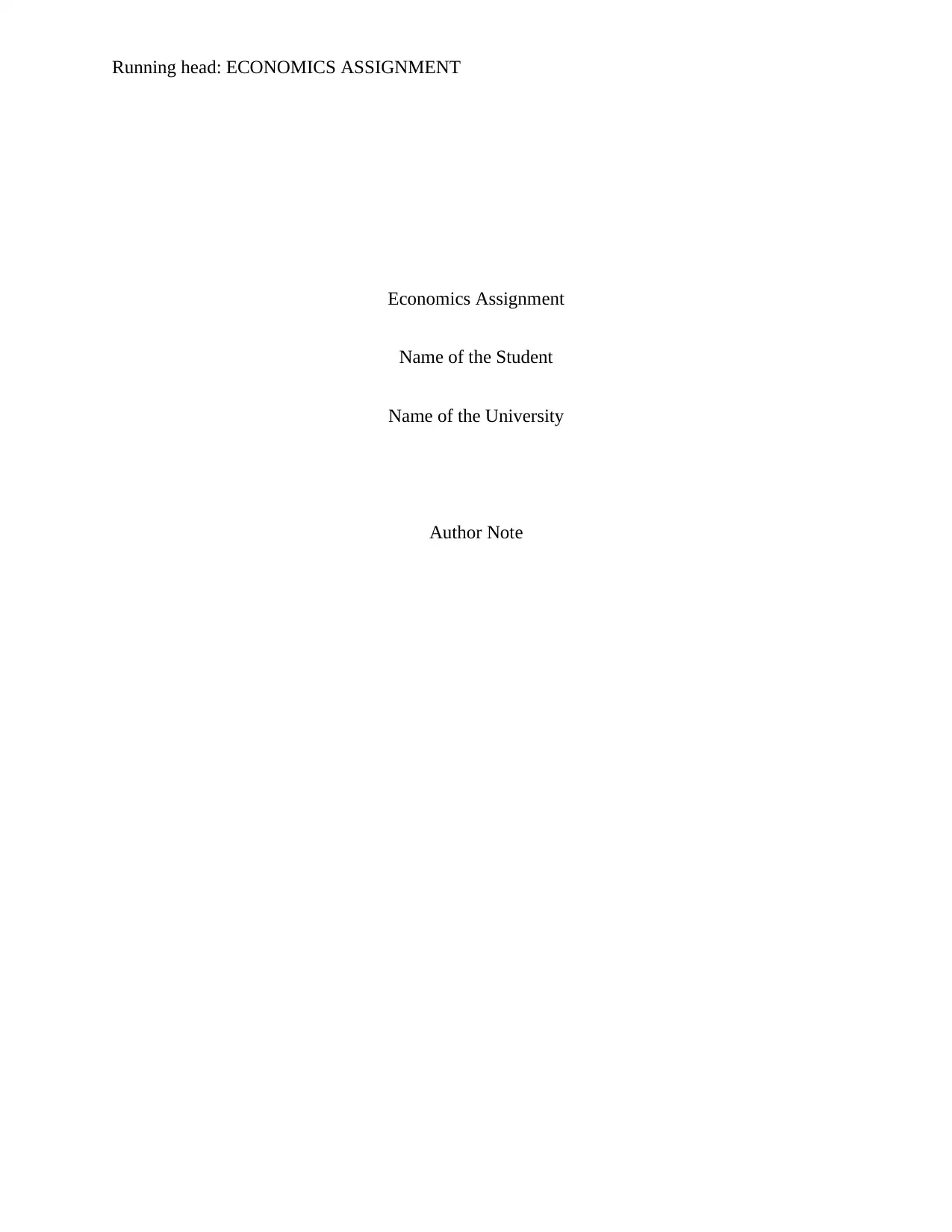
Running head: ECONOMICS ASSIGNMENT
Economics Assignment
Name of the Student
Name of the University
Author Note
Economics Assignment
Name of the Student
Name of the University
Author Note
Paraphrase This Document
Need a fresh take? Get an instant paraphrase of this document with our AI Paraphraser

1ECONOMICS ASSIGNMENT
Table of Contents
Introduction:....................................................................................................................................2
Answer 1:.........................................................................................................................................2
Answer 2:.........................................................................................................................................3
Answer 3:.......................................................................................................................................10
Answer 4:.......................................................................................................................................12
Answer 5:.......................................................................................................................................14
References......................................................................................................................................16
Table of Contents
Introduction:....................................................................................................................................2
Answer 1:.........................................................................................................................................2
Answer 2:.........................................................................................................................................3
Answer 3:.......................................................................................................................................10
Answer 4:.......................................................................................................................................12
Answer 5:.......................................................................................................................................14
References......................................................................................................................................16
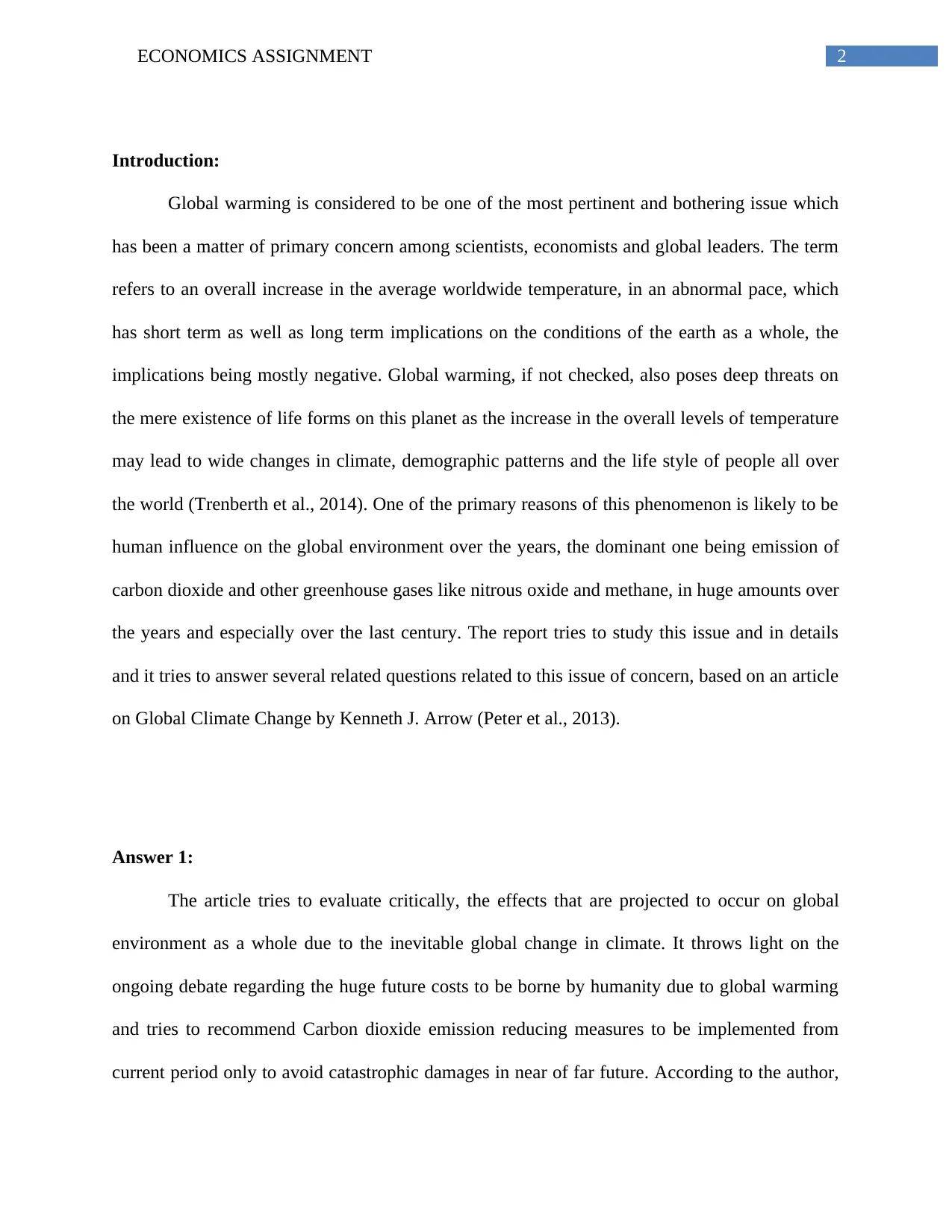
2ECONOMICS ASSIGNMENT
Introduction:
Global warming is considered to be one of the most pertinent and bothering issue which
has been a matter of primary concern among scientists, economists and global leaders. The term
refers to an overall increase in the average worldwide temperature, in an abnormal pace, which
has short term as well as long term implications on the conditions of the earth as a whole, the
implications being mostly negative. Global warming, if not checked, also poses deep threats on
the mere existence of life forms on this planet as the increase in the overall levels of temperature
may lead to wide changes in climate, demographic patterns and the life style of people all over
the world (Trenberth et al., 2014). One of the primary reasons of this phenomenon is likely to be
human influence on the global environment over the years, the dominant one being emission of
carbon dioxide and other greenhouse gases like nitrous oxide and methane, in huge amounts over
the years and especially over the last century. The report tries to study this issue and in details
and it tries to answer several related questions related to this issue of concern, based on an article
on Global Climate Change by Kenneth J. Arrow (Peter et al., 2013).
Answer 1:
The article tries to evaluate critically, the effects that are projected to occur on global
environment as a whole due to the inevitable global change in climate. It throws light on the
ongoing debate regarding the huge future costs to be borne by humanity due to global warming
and tries to recommend Carbon dioxide emission reducing measures to be implemented from
current period only to avoid catastrophic damages in near of far future. According to the author,
Introduction:
Global warming is considered to be one of the most pertinent and bothering issue which
has been a matter of primary concern among scientists, economists and global leaders. The term
refers to an overall increase in the average worldwide temperature, in an abnormal pace, which
has short term as well as long term implications on the conditions of the earth as a whole, the
implications being mostly negative. Global warming, if not checked, also poses deep threats on
the mere existence of life forms on this planet as the increase in the overall levels of temperature
may lead to wide changes in climate, demographic patterns and the life style of people all over
the world (Trenberth et al., 2014). One of the primary reasons of this phenomenon is likely to be
human influence on the global environment over the years, the dominant one being emission of
carbon dioxide and other greenhouse gases like nitrous oxide and methane, in huge amounts over
the years and especially over the last century. The report tries to study this issue and in details
and it tries to answer several related questions related to this issue of concern, based on an article
on Global Climate Change by Kenneth J. Arrow (Peter et al., 2013).
Answer 1:
The article tries to evaluate critically, the effects that are projected to occur on global
environment as a whole due to the inevitable global change in climate. It throws light on the
ongoing debate regarding the huge future costs to be borne by humanity due to global warming
and tries to recommend Carbon dioxide emission reducing measures to be implemented from
current period only to avoid catastrophic damages in near of far future. According to the author,
⊘ This is a preview!⊘
Do you want full access?
Subscribe today to unlock all pages.

Trusted by 1+ million students worldwide
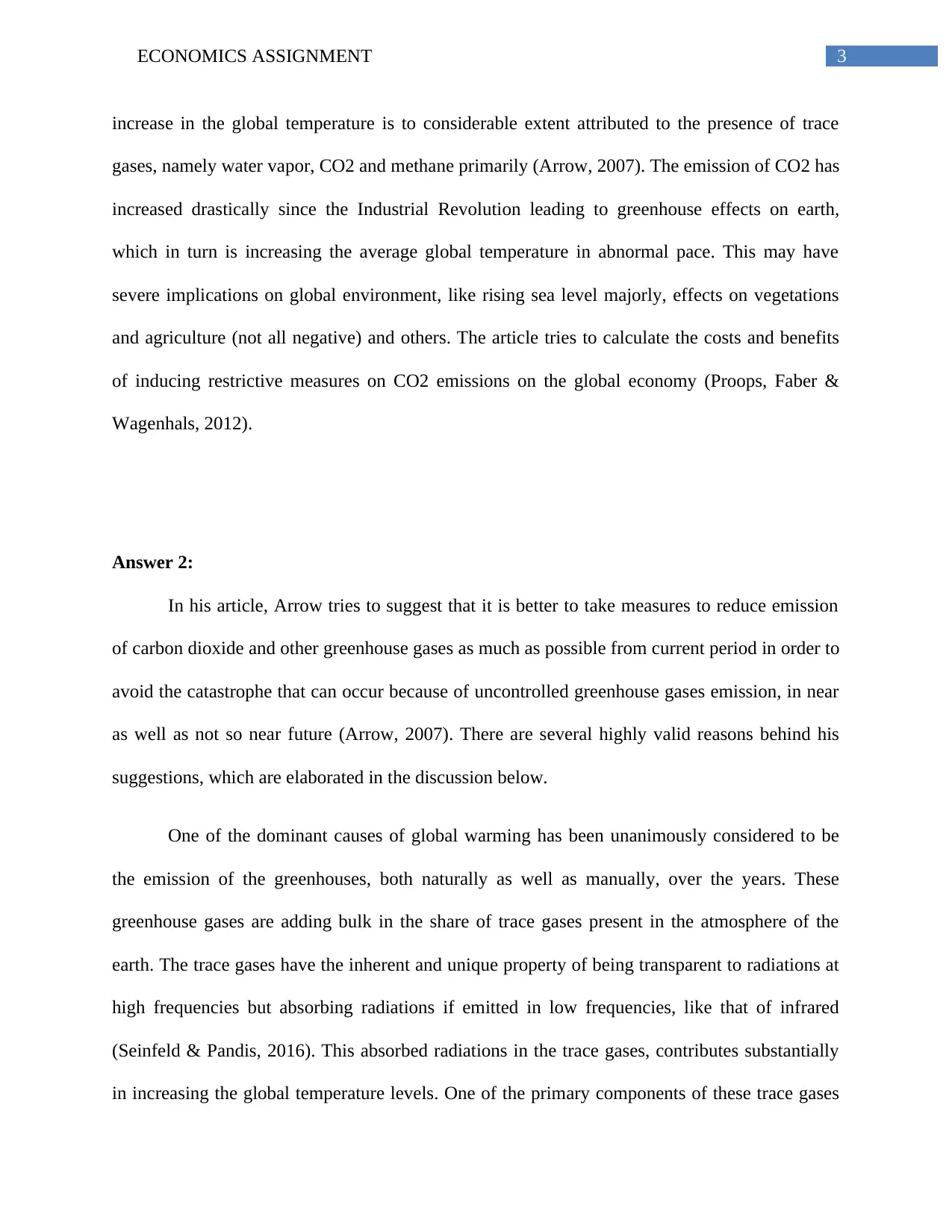
3ECONOMICS ASSIGNMENT
increase in the global temperature is to considerable extent attributed to the presence of trace
gases, namely water vapor, CO2 and methane primarily (Arrow, 2007). The emission of CO2 has
increased drastically since the Industrial Revolution leading to greenhouse effects on earth,
which in turn is increasing the average global temperature in abnormal pace. This may have
severe implications on global environment, like rising sea level majorly, effects on vegetations
and agriculture (not all negative) and others. The article tries to calculate the costs and benefits
of inducing restrictive measures on CO2 emissions on the global economy (Proops, Faber &
Wagenhals, 2012).
Answer 2:
In his article, Arrow tries to suggest that it is better to take measures to reduce emission
of carbon dioxide and other greenhouse gases as much as possible from current period in order to
avoid the catastrophe that can occur because of uncontrolled greenhouse gases emission, in near
as well as not so near future (Arrow, 2007). There are several highly valid reasons behind his
suggestions, which are elaborated in the discussion below.
One of the dominant causes of global warming has been unanimously considered to be
the emission of the greenhouses, both naturally as well as manually, over the years. These
greenhouse gases are adding bulk in the share of trace gases present in the atmosphere of the
earth. The trace gases have the inherent and unique property of being transparent to radiations at
high frequencies but absorbing radiations if emitted in low frequencies, like that of infrared
(Seinfeld & Pandis, 2016). This absorbed radiations in the trace gases, contributes substantially
in increasing the global temperature levels. One of the primary components of these trace gases
increase in the global temperature is to considerable extent attributed to the presence of trace
gases, namely water vapor, CO2 and methane primarily (Arrow, 2007). The emission of CO2 has
increased drastically since the Industrial Revolution leading to greenhouse effects on earth,
which in turn is increasing the average global temperature in abnormal pace. This may have
severe implications on global environment, like rising sea level majorly, effects on vegetations
and agriculture (not all negative) and others. The article tries to calculate the costs and benefits
of inducing restrictive measures on CO2 emissions on the global economy (Proops, Faber &
Wagenhals, 2012).
Answer 2:
In his article, Arrow tries to suggest that it is better to take measures to reduce emission
of carbon dioxide and other greenhouse gases as much as possible from current period in order to
avoid the catastrophe that can occur because of uncontrolled greenhouse gases emission, in near
as well as not so near future (Arrow, 2007). There are several highly valid reasons behind his
suggestions, which are elaborated in the discussion below.
One of the dominant causes of global warming has been unanimously considered to be
the emission of the greenhouses, both naturally as well as manually, over the years. These
greenhouse gases are adding bulk in the share of trace gases present in the atmosphere of the
earth. The trace gases have the inherent and unique property of being transparent to radiations at
high frequencies but absorbing radiations if emitted in low frequencies, like that of infrared
(Seinfeld & Pandis, 2016). This absorbed radiations in the trace gases, contributes substantially
in increasing the global temperature levels. One of the primary components of these trace gases
Paraphrase This Document
Need a fresh take? Get an instant paraphrase of this document with our AI Paraphraser
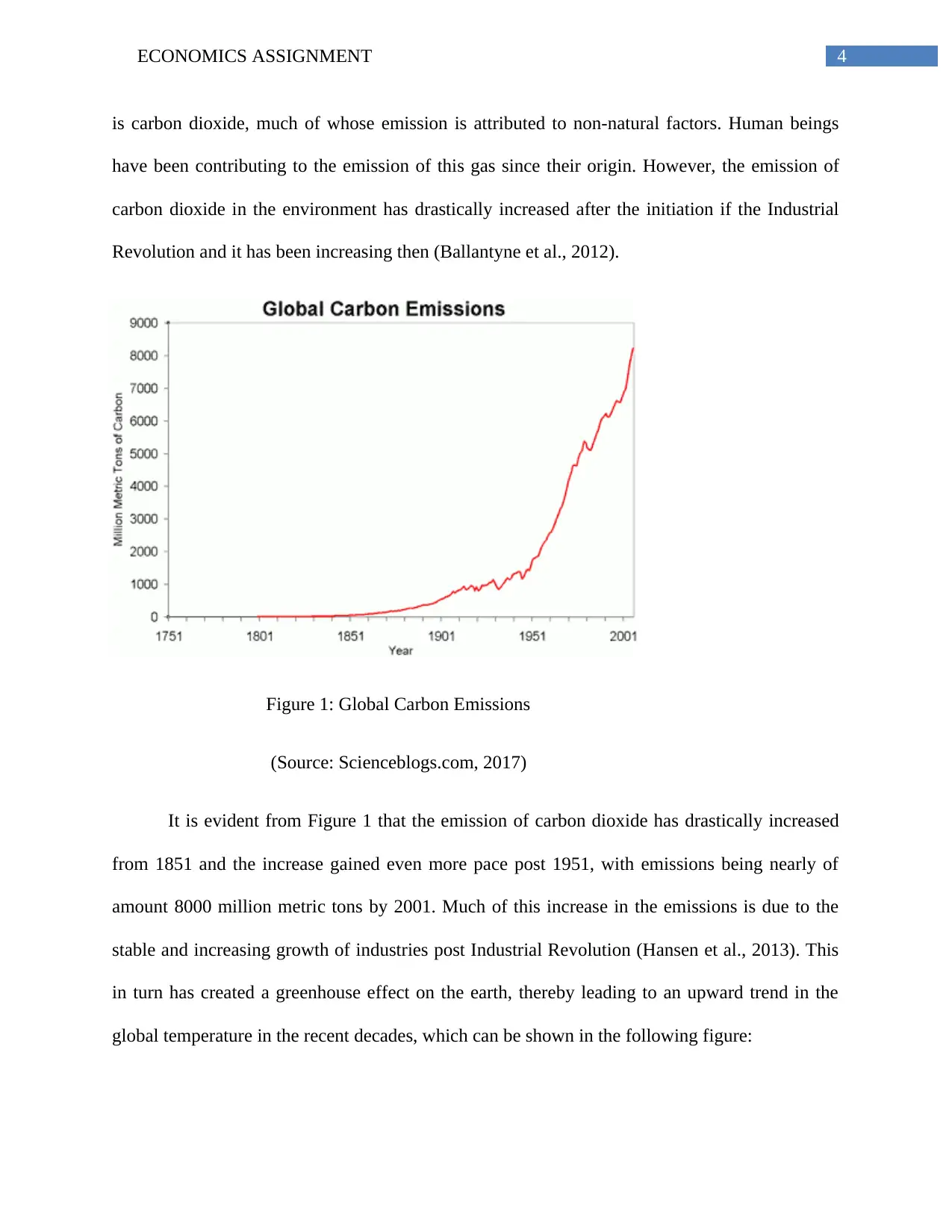
4ECONOMICS ASSIGNMENT
is carbon dioxide, much of whose emission is attributed to non-natural factors. Human beings
have been contributing to the emission of this gas since their origin. However, the emission of
carbon dioxide in the environment has drastically increased after the initiation if the Industrial
Revolution and it has been increasing then (Ballantyne et al., 2012).
Figure 1: Global Carbon Emissions
(Source: Scienceblogs.com, 2017)
It is evident from Figure 1 that the emission of carbon dioxide has drastically increased
from 1851 and the increase gained even more pace post 1951, with emissions being nearly of
amount 8000 million metric tons by 2001. Much of this increase in the emissions is due to the
stable and increasing growth of industries post Industrial Revolution (Hansen et al., 2013). This
in turn has created a greenhouse effect on the earth, thereby leading to an upward trend in the
global temperature in the recent decades, which can be shown in the following figure:
is carbon dioxide, much of whose emission is attributed to non-natural factors. Human beings
have been contributing to the emission of this gas since their origin. However, the emission of
carbon dioxide in the environment has drastically increased after the initiation if the Industrial
Revolution and it has been increasing then (Ballantyne et al., 2012).
Figure 1: Global Carbon Emissions
(Source: Scienceblogs.com, 2017)
It is evident from Figure 1 that the emission of carbon dioxide has drastically increased
from 1851 and the increase gained even more pace post 1951, with emissions being nearly of
amount 8000 million metric tons by 2001. Much of this increase in the emissions is due to the
stable and increasing growth of industries post Industrial Revolution (Hansen et al., 2013). This
in turn has created a greenhouse effect on the earth, thereby leading to an upward trend in the
global temperature in the recent decades, which can be shown in the following figure:

5ECONOMICS ASSIGNMENT
Figure 2: CO2 and Temperature Changes over Twentieth Century
(Source: Scienceblogs.com, 2017)
The above figure shows a direct positive correlation between the emission of carbon
dioxide and increase in the global temperature as both has almost proportionately increased with
time. This shows that the concern as put forward by Arrow has significant relevance and it needs
to be addressed with priority (Hansen, Sato & Ruedy, 2012).
Research shows that the level of carbon dioxide emissions has currently increased from
280 parts per million before Industrial Revolution, to almost 430 parts per million post the
Revolution and if the current pace is not slowed down, carbon emissions are expected to increase
up to 550 parts per million by 2035, which is scarily high (Arrow, 2007). The projected level of
carbon dioxide emission is almost two times as high as that was during the times prior to
Figure 2: CO2 and Temperature Changes over Twentieth Century
(Source: Scienceblogs.com, 2017)
The above figure shows a direct positive correlation between the emission of carbon
dioxide and increase in the global temperature as both has almost proportionately increased with
time. This shows that the concern as put forward by Arrow has significant relevance and it needs
to be addressed with priority (Hansen, Sato & Ruedy, 2012).
Research shows that the level of carbon dioxide emissions has currently increased from
280 parts per million before Industrial Revolution, to almost 430 parts per million post the
Revolution and if the current pace is not slowed down, carbon emissions are expected to increase
up to 550 parts per million by 2035, which is scarily high (Arrow, 2007). The projected level of
carbon dioxide emission is almost two times as high as that was during the times prior to
⊘ This is a preview!⊘
Do you want full access?
Subscribe today to unlock all pages.

Trusted by 1+ million students worldwide
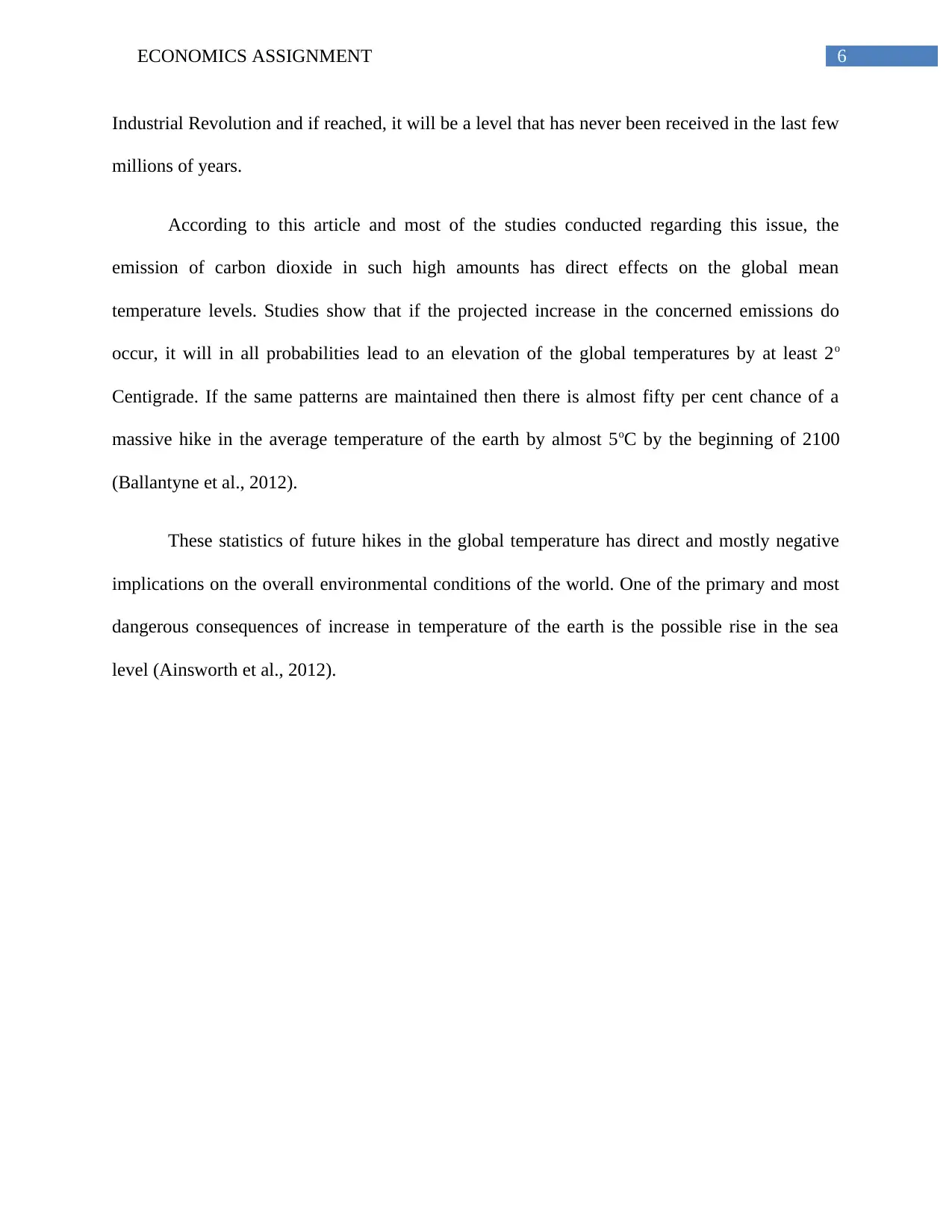
6ECONOMICS ASSIGNMENT
Industrial Revolution and if reached, it will be a level that has never been received in the last few
millions of years.
According to this article and most of the studies conducted regarding this issue, the
emission of carbon dioxide in such high amounts has direct effects on the global mean
temperature levels. Studies show that if the projected increase in the concerned emissions do
occur, it will in all probabilities lead to an elevation of the global temperatures by at least 2o
Centigrade. If the same patterns are maintained then there is almost fifty per cent chance of a
massive hike in the average temperature of the earth by almost 5oC by the beginning of 2100
(Ballantyne et al., 2012).
These statistics of future hikes in the global temperature has direct and mostly negative
implications on the overall environmental conditions of the world. One of the primary and most
dangerous consequences of increase in temperature of the earth is the possible rise in the sea
level (Ainsworth et al., 2012).
Industrial Revolution and if reached, it will be a level that has never been received in the last few
millions of years.
According to this article and most of the studies conducted regarding this issue, the
emission of carbon dioxide in such high amounts has direct effects on the global mean
temperature levels. Studies show that if the projected increase in the concerned emissions do
occur, it will in all probabilities lead to an elevation of the global temperatures by at least 2o
Centigrade. If the same patterns are maintained then there is almost fifty per cent chance of a
massive hike in the average temperature of the earth by almost 5oC by the beginning of 2100
(Ballantyne et al., 2012).
These statistics of future hikes in the global temperature has direct and mostly negative
implications on the overall environmental conditions of the world. One of the primary and most
dangerous consequences of increase in temperature of the earth is the possible rise in the sea
level (Ainsworth et al., 2012).
Paraphrase This Document
Need a fresh take? Get an instant paraphrase of this document with our AI Paraphraser
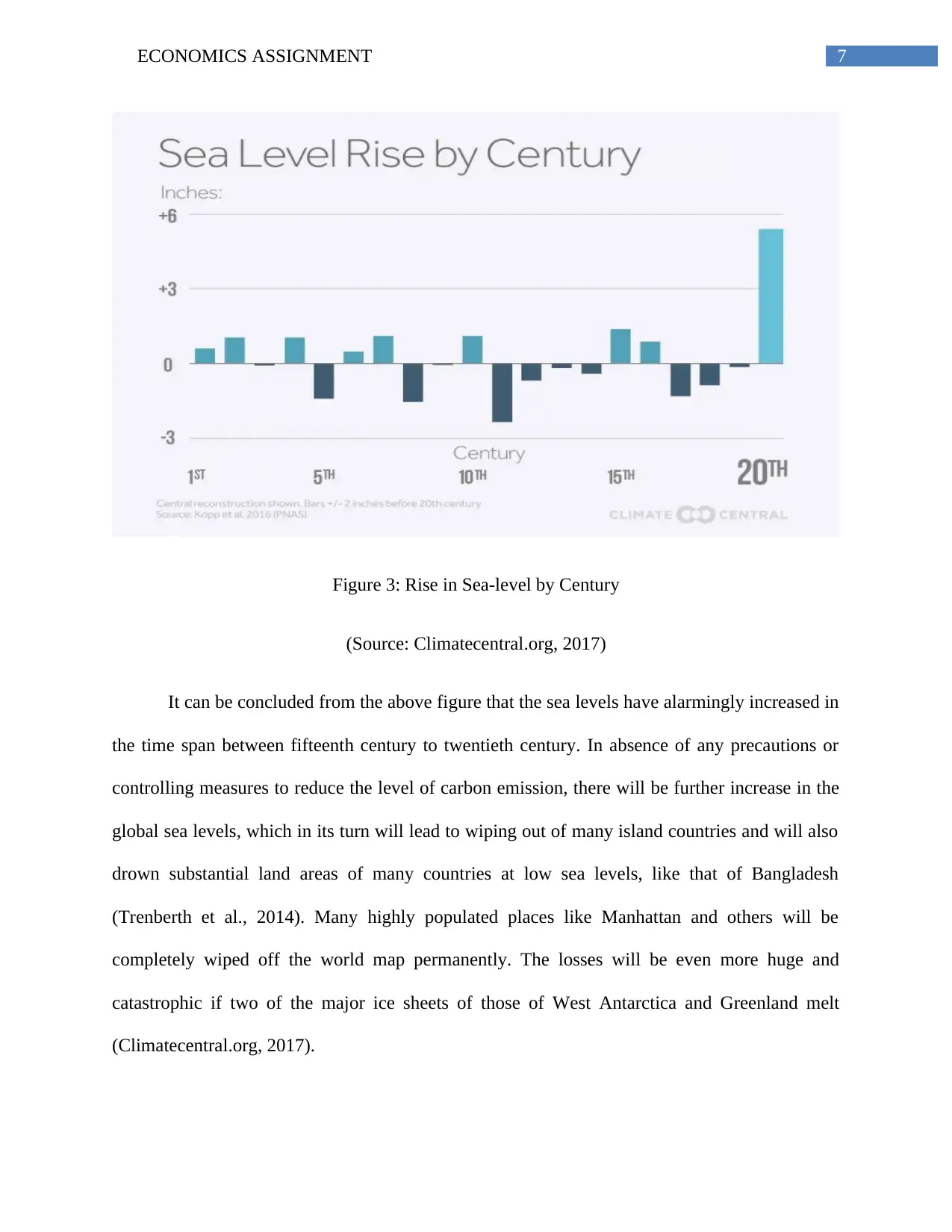
7ECONOMICS ASSIGNMENT
Figure 3: Rise in Sea-level by Century
(Source: Climatecentral.org, 2017)
It can be concluded from the above figure that the sea levels have alarmingly increased in
the time span between fifteenth century to twentieth century. In absence of any precautions or
controlling measures to reduce the level of carbon emission, there will be further increase in the
global sea levels, which in its turn will lead to wiping out of many island countries and will also
drown substantial land areas of many countries at low sea levels, like that of Bangladesh
(Trenberth et al., 2014). Many highly populated places like Manhattan and others will be
completely wiped off the world map permanently. The losses will be even more huge and
catastrophic if two of the major ice sheets of those of West Antarctica and Greenland melt
(Climatecentral.org, 2017).
Figure 3: Rise in Sea-level by Century
(Source: Climatecentral.org, 2017)
It can be concluded from the above figure that the sea levels have alarmingly increased in
the time span between fifteenth century to twentieth century. In absence of any precautions or
controlling measures to reduce the level of carbon emission, there will be further increase in the
global sea levels, which in its turn will lead to wiping out of many island countries and will also
drown substantial land areas of many countries at low sea levels, like that of Bangladesh
(Trenberth et al., 2014). Many highly populated places like Manhattan and others will be
completely wiped off the world map permanently. The losses will be even more huge and
catastrophic if two of the major ice sheets of those of West Antarctica and Greenland melt
(Climatecentral.org, 2017).

8ECONOMICS ASSIGNMENT
One of the other significant consequences of this unfavorable phenomenon, is the
projected changes in the global climatic patterns. With the current trends continuing, there are
high chances of countries in Europe to experience climatic conditions of that of Greenland.
There will be changes in the nature and intensities of the tropical storms too, leading to greater
destructions of lives and properties (Goulder, 2013). Other consequences of global warming
include decrease in the glacial reserves of the world, which can lead to a tremendous shortage in
the water supplies. Much of the vegetations on earth and the current agricultural patterns will
also be significantly affected by these changes, which are expected to have direct impacts on
human lifestyles almost in all parts of the world (Hansen, Sato & Ruedy, 2012).
Collectively, these pose serious threats to the existence of life forms and the quality of
life in the future, creating confusions and questions regarding the future of the world. To avoid
these massive negative consequences in the coming periods, immediate and appropriate
measures are indeed required as been rightly suggested by the author.
Sources of Market Failure:
In economics, market failure is said to have occurred if the market fails to maximize the
welfare of the society as a whole. This concept is highly relevant in the concerned issue. It is
highly evident from almost all the research conducted on this field that the emission of CO2 has
significantly increased with the advent of the Industrial Revolution. The fruits of this Industrial
Revolution, however, have been mainly enjoyed by the current developed countries as it fuelled
their economic growth and prosperity significantly (Keohane & Olmstead, 2016). Due to absence
of proper awareness of the future long term threats of carbon emission on the world, these
countries have in general contributed significantly in the global levels of carbon emission, the
One of the other significant consequences of this unfavorable phenomenon, is the
projected changes in the global climatic patterns. With the current trends continuing, there are
high chances of countries in Europe to experience climatic conditions of that of Greenland.
There will be changes in the nature and intensities of the tropical storms too, leading to greater
destructions of lives and properties (Goulder, 2013). Other consequences of global warming
include decrease in the glacial reserves of the world, which can lead to a tremendous shortage in
the water supplies. Much of the vegetations on earth and the current agricultural patterns will
also be significantly affected by these changes, which are expected to have direct impacts on
human lifestyles almost in all parts of the world (Hansen, Sato & Ruedy, 2012).
Collectively, these pose serious threats to the existence of life forms and the quality of
life in the future, creating confusions and questions regarding the future of the world. To avoid
these massive negative consequences in the coming periods, immediate and appropriate
measures are indeed required as been rightly suggested by the author.
Sources of Market Failure:
In economics, market failure is said to have occurred if the market fails to maximize the
welfare of the society as a whole. This concept is highly relevant in the concerned issue. It is
highly evident from almost all the research conducted on this field that the emission of CO2 has
significantly increased with the advent of the Industrial Revolution. The fruits of this Industrial
Revolution, however, have been mainly enjoyed by the current developed countries as it fuelled
their economic growth and prosperity significantly (Keohane & Olmstead, 2016). Due to absence
of proper awareness of the future long term threats of carbon emission on the world, these
countries have in general contributed significantly in the global levels of carbon emission, the
⊘ This is a preview!⊘
Do you want full access?
Subscribe today to unlock all pages.

Trusted by 1+ million students worldwide

9ECONOMICS ASSIGNMENT
burden of which has to be borne by the future generations. In this case, the cost of global
warming, primarily created by the developed countries are not borne by them in general. Much
of the costs are to be borne by the developing and poor countries as much of the restrictive
policies are implemented now on them, thereby making them face a tradeoff between their own
economic growth and long term global welfare. These are the primary sources of market failure
in this scenario (Goulder, 2013).
Possible Solutions to Problems for Global Warming:
Several measures can be undertaken globally, to reduce the levels of current carbon
emission or to at least restrict it to current levels. Few of such measures are discussed as follows:
a) Replacing energy resources used currently, like coal and fossil fuels, by those whose carbon
emission rates are comparatively lower, like natural gases, can help in reducing the emission
rates significantly (Williams et al., 2012).
b) Innovations are highly necessary to create technologies which tend to lower the intensity of
energy input for production purposes. If created, fast and effective implementations of such
technologies by developed as well as developing countries can help in reducing the credible
threat if global warming to considerable extent (Proops, Faber & Wagenhals, 2012).
c) Manual deforestations has been one of the factors contributing to the current threats of global
warming. Therefore, rapid initiatives of planting trees worldwide can lead to reduction in the
threats of global warming as plants absorb carbon dioxide, which is one of the primary
components of greenhouse gases (Williams et al., 2012).
burden of which has to be borne by the future generations. In this case, the cost of global
warming, primarily created by the developed countries are not borne by them in general. Much
of the costs are to be borne by the developing and poor countries as much of the restrictive
policies are implemented now on them, thereby making them face a tradeoff between their own
economic growth and long term global welfare. These are the primary sources of market failure
in this scenario (Goulder, 2013).
Possible Solutions to Problems for Global Warming:
Several measures can be undertaken globally, to reduce the levels of current carbon
emission or to at least restrict it to current levels. Few of such measures are discussed as follows:
a) Replacing energy resources used currently, like coal and fossil fuels, by those whose carbon
emission rates are comparatively lower, like natural gases, can help in reducing the emission
rates significantly (Williams et al., 2012).
b) Innovations are highly necessary to create technologies which tend to lower the intensity of
energy input for production purposes. If created, fast and effective implementations of such
technologies by developed as well as developing countries can help in reducing the credible
threat if global warming to considerable extent (Proops, Faber & Wagenhals, 2012).
c) Manual deforestations has been one of the factors contributing to the current threats of global
warming. Therefore, rapid initiatives of planting trees worldwide can lead to reduction in the
threats of global warming as plants absorb carbon dioxide, which is one of the primary
components of greenhouse gases (Williams et al., 2012).
Paraphrase This Document
Need a fresh take? Get an instant paraphrase of this document with our AI Paraphraser

10ECONOMICS ASSIGNMENT
d) The developed countries being technologically privileged and having enjoying the fruits of
technological renaissance at the cost of growth of the developing countries, it will be judicious
on their part to take initiatives to control carbon emission and to lead others in achieving the
collective targets of averting global warming (Keohane & Olmstead, 2016).
Answer 3:
In this article, to see the preferences of people in general, between current and future
outcomes, especially consumption, the following formula has been used:
δ = ρ+gη
Here, δ shows the consumption discount rate, which indicates the rate at which an
individual tend to discount losses that will occur in future consumption given that the individual
wants to consume in the present period. In other words, it shows the individuals preference of
current consumption over future consumption. Higher δ implies higher consumption discount
rate, which means the individuals prefer current consumption more to future consumptions
(Goulder & WILLIAMS III, 2012).
Here, ρ signifies the time preference rate, which shows the preference between current
and future well being. Higher the value of this symbol indicates higher preference of current
welfare over future welfare. In this equation, g shows the expected rate of growth of mean
consumption whereas η shows the social weight elasticity due to change in the level of
consumption. η basically resembles the concept of diminishing marginal utility from
consumption as consumption increases (Pindyck, 2013).
d) The developed countries being technologically privileged and having enjoying the fruits of
technological renaissance at the cost of growth of the developing countries, it will be judicious
on their part to take initiatives to control carbon emission and to lead others in achieving the
collective targets of averting global warming (Keohane & Olmstead, 2016).
Answer 3:
In this article, to see the preferences of people in general, between current and future
outcomes, especially consumption, the following formula has been used:
δ = ρ+gη
Here, δ shows the consumption discount rate, which indicates the rate at which an
individual tend to discount losses that will occur in future consumption given that the individual
wants to consume in the present period. In other words, it shows the individuals preference of
current consumption over future consumption. Higher δ implies higher consumption discount
rate, which means the individuals prefer current consumption more to future consumptions
(Goulder & WILLIAMS III, 2012).
Here, ρ signifies the time preference rate, which shows the preference between current
and future well being. Higher the value of this symbol indicates higher preference of current
welfare over future welfare. In this equation, g shows the expected rate of growth of mean
consumption whereas η shows the social weight elasticity due to change in the level of
consumption. η basically resembles the concept of diminishing marginal utility from
consumption as consumption increases (Pindyck, 2013).
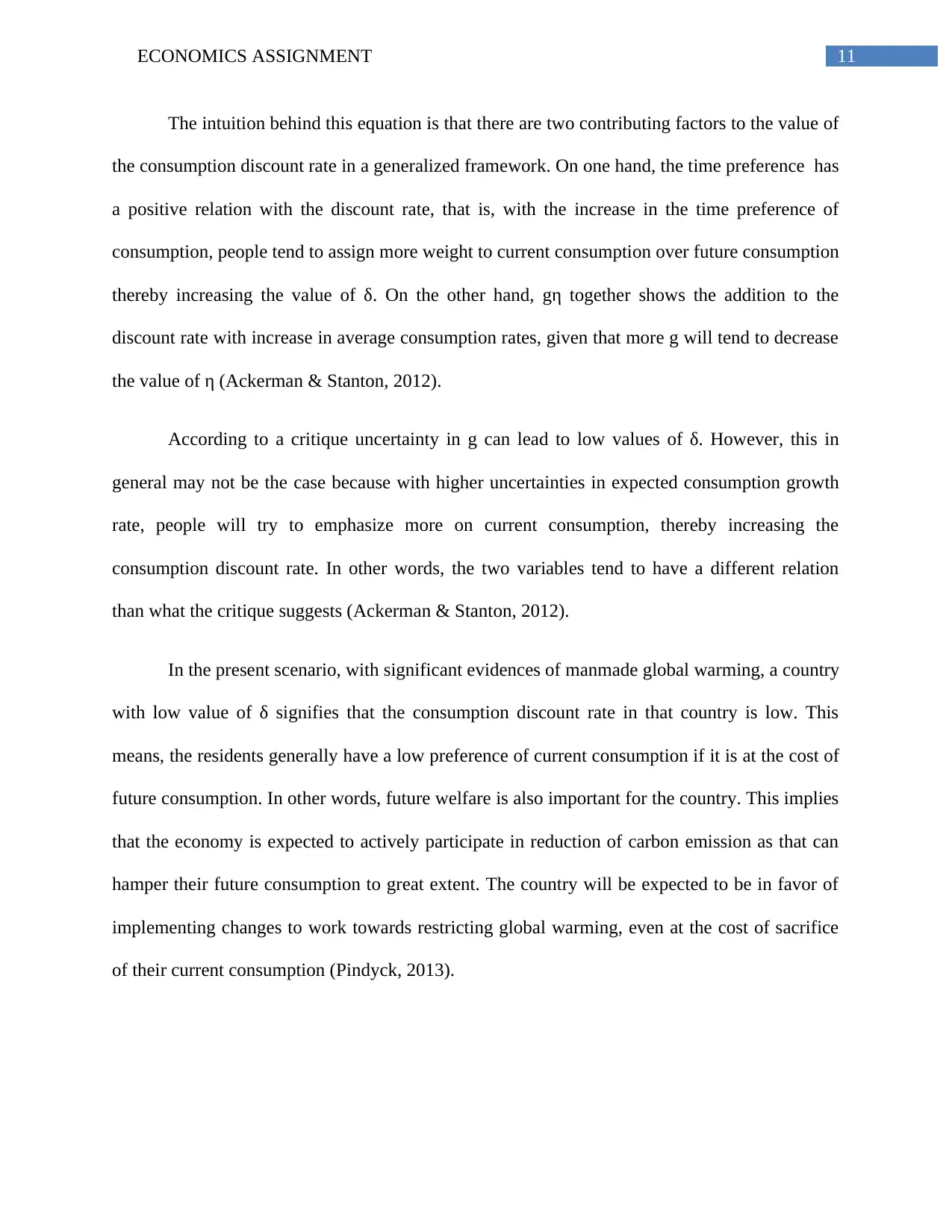
11ECONOMICS ASSIGNMENT
The intuition behind this equation is that there are two contributing factors to the value of
the consumption discount rate in a generalized framework. On one hand, the time preference has
a positive relation with the discount rate, that is, with the increase in the time preference of
consumption, people tend to assign more weight to current consumption over future consumption
thereby increasing the value of δ. On the other hand, gη together shows the addition to the
discount rate with increase in average consumption rates, given that more g will tend to decrease
the value of η (Ackerman & Stanton, 2012).
According to a critique uncertainty in g can lead to low values of δ. However, this in
general may not be the case because with higher uncertainties in expected consumption growth
rate, people will try to emphasize more on current consumption, thereby increasing the
consumption discount rate. In other words, the two variables tend to have a different relation
than what the critique suggests (Ackerman & Stanton, 2012).
In the present scenario, with significant evidences of manmade global warming, a country
with low value of δ signifies that the consumption discount rate in that country is low. This
means, the residents generally have a low preference of current consumption if it is at the cost of
future consumption. In other words, future welfare is also important for the country. This implies
that the economy is expected to actively participate in reduction of carbon emission as that can
hamper their future consumption to great extent. The country will be expected to be in favor of
implementing changes to work towards restricting global warming, even at the cost of sacrifice
of their current consumption (Pindyck, 2013).
The intuition behind this equation is that there are two contributing factors to the value of
the consumption discount rate in a generalized framework. On one hand, the time preference has
a positive relation with the discount rate, that is, with the increase in the time preference of
consumption, people tend to assign more weight to current consumption over future consumption
thereby increasing the value of δ. On the other hand, gη together shows the addition to the
discount rate with increase in average consumption rates, given that more g will tend to decrease
the value of η (Ackerman & Stanton, 2012).
According to a critique uncertainty in g can lead to low values of δ. However, this in
general may not be the case because with higher uncertainties in expected consumption growth
rate, people will try to emphasize more on current consumption, thereby increasing the
consumption discount rate. In other words, the two variables tend to have a different relation
than what the critique suggests (Ackerman & Stanton, 2012).
In the present scenario, with significant evidences of manmade global warming, a country
with low value of δ signifies that the consumption discount rate in that country is low. This
means, the residents generally have a low preference of current consumption if it is at the cost of
future consumption. In other words, future welfare is also important for the country. This implies
that the economy is expected to actively participate in reduction of carbon emission as that can
hamper their future consumption to great extent. The country will be expected to be in favor of
implementing changes to work towards restricting global warming, even at the cost of sacrifice
of their current consumption (Pindyck, 2013).
⊘ This is a preview!⊘
Do you want full access?
Subscribe today to unlock all pages.

Trusted by 1+ million students worldwide
1 out of 19
Related Documents
Your All-in-One AI-Powered Toolkit for Academic Success.
+13062052269
info@desklib.com
Available 24*7 on WhatsApp / Email
![[object Object]](/_next/static/media/star-bottom.7253800d.svg)
Unlock your academic potential
Copyright © 2020–2025 A2Z Services. All Rights Reserved. Developed and managed by ZUCOL.





